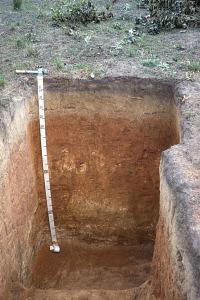|
| Ap 0-14 cm |
light brownish grey (10YR 6/2, dry) (10YR 3.5/1.5, moist)sandy clay loam,weak very fine and fine subangular blocky and weak very fine and fine granular,slightly hard very friable slightly sticky slightly plastic,no cutans,many very fine fine pores and many pores,abrupt smooth boundary to, |
| E1 14-30 cm |
yellowish brown (10YR 5/4, moist) pale brown (10YR 6/3, dry)sandy clay loam,strongly coherent porous massive,very hard very friable slightly sticky slightly plastic,no cutans,common very fine fine pores,clear wavy boundary to, |
| E2 30-38 cm |
yellowish brown (10YR 5/4, moist) pale brown (10YR 6/3, dry)sandy clay loam gravelly,strongly coherent porous massive,very hard friable slightly sticky slightly plastic,no cutans,common very fine fine pores,few fine gravel strongly weathered quartz fragments,clear wavy boundary to, |
| Bt1 38-50 cm |
red (2.5YR 4/6, moist) reddish yellow (5YR 6/6, dry)clay,moderate fine and medium subangular blocky and moderate fine and medium angular blocky,very hard friable very sticky very plastic,broken thick clay cutans,common pores,gradual wavy boundary to, |
| Bt2 50-80 cm |
red (2.5YR 4/6, moist) light red (2.5YR 6/6, dry)clay,moderate fine and medium subangular blocky and moderate fine and medium angular blocky,very hard friable very sticky very plastic,broken thick clay cutans,gradual wavy boundary to, |
| Bt3 80-100 cm |
yellowish red (5YR 4/6, moist) reddish yellow (5YR 6/6, dry)clay loam,moderate fine and medium subangular blocky,very hard friable very sticky very plastic,broken moderately thick clay cutans,very few fine gravel strongly weathered not identified fragments,gradual irregular boundary to, |
| CB 100-157 cm |
yellowish red (5YR 4/6, moist) reddish yellow (7.5YR 6/6, dry)sandy clay loam,weak medium subangular blocky to moderately coherent porous massive,hard very friable sticky plastic,few fine gravel strongly weathered not identified fragments,gradual wavy boundary to, |
|
| C 157-180 cm |
yellow (10YR 7/6, dry) reddish yellow (7.5YR 6/6, moist)moderately coherent porous massive,slightly hard very friable slightly sticky slightly plastic,frequent fine gravel strongly weathered not identified fragments, |
